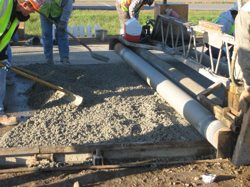Project Details
03/01/21
08/31/21
Ready Mixed Concrete Research and Education Foundation
Researchers
Gordon Smith
About the research
The Guide to Concrete Overlays of Asphalt Parking Lots provides information for decision-makers and practitioners about selecting, designing, and constructing successful concrete overlays on existing asphalt parking lot pavements that serve public, commercial, or multifamily residential buildings. The guide focuses on parking areas that carry and store light vehicles (primarily automobiles and pickup trucks), but it also addresses adjacent access roads and truck lanes that regularly carry heavy trucks for the delivery and pickup of goods and materials, including solid waste containers.
This document offers expert guidance to supplement practitioners’ own professional experience and judgment. With this information, parking lot owners can confidently include concrete overlays in their toolbox of asphalt parking lot maintenance solutions and make informed decisions about overlay design and construction based on existing asphalt conditions.
The following material has been updated or added for the second edition of this guide:
- The information on pavement assessment has been simplified.
- Information has been added on designing around fixed elevations.
- An overlay strategy flowchart has been added.
- The information on macrofibers has been updated.
- Project profiles demonstrating the principles of this guide have been added.
- Information has been added on laser-guided screed texture and cure equipment.
Information on distress identification and the key points of materials and construction have been relocated to appendices.
Project Details
06/01/18
08/01/19
Ready Mixed Concrete Research and Education Foundation
Researchers
Gordon Smith
About the research
The purpose of the Guide to Concrete Trails is to provide guidance to the ready-mixed concrete industry, contractors, design professionals, decision makers, practitioners, and public agencies on the design, construction, and maintenance of concrete trails and paths that help to improve the transportation and recreation opportunities of the general public.
The guide focuses on the development steps, design parameters and options, important elements of construction from subgrade preparation to delivery, use of various and sometimes innovative construction equipment, as well as concrete trail maintenance and repair. Finally, the guide offers case studies from projects located throughout the country on concrete trails of all ages, including various construction methods.
The guide’s goal is to provide comprehensive guidance at a national level. Such guidance is useful for construction of all types of paved recreational trails, including those for biking, running, and walking, and of other pathways such as cart paths on golf courses.
Project Details
04/01/07
10/31/11
Federal Highway Administration
Ready Mixed Concrete Research and Education Foundation
Researchers
Vern Schaefer
Paul Wiegand
John T. Kevern
About the research
This report presents the results of the largest and most comprehensive study to date on portland cement pervious concrete (PCPC). It is designed to be widely accessible and easily applied by designers, producers, contractors, and owners.
The project was designed to begin with pervious concrete best practices and then to address the unanswered questions in a systematic fashion to allow a successful overlay project. Consequently, the first portion of the integrated project involved a combination of fundamental material property investigations, test method development, and addressing constructability issues before actual construction could take place. The second portion of the project involved actual construction and long-term testing before reporting successes, failures, and lessons learned.
The results of the studies conducted show that a pervious concrete overlay can be designed, constructed, operated, and maintained. A pervious concrete overlay has several inherent advantages, including reduced splash and spray and reduced hydroplaning potential, as well as being a very quiet pavement. The good performance of this overlay in a particularly harsh freeze-thaw climate, Minnesota, shows pervious concrete is durable and can be successfully used in freeze-thaw climates with truck traffic and heavy snow plowing.
